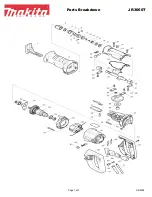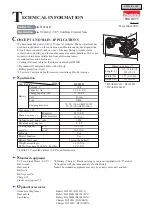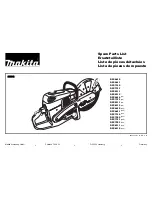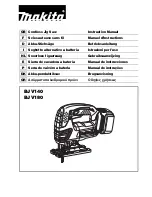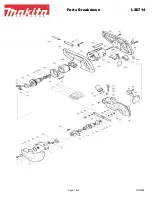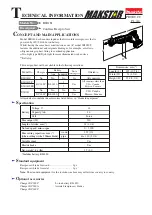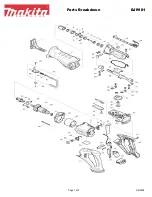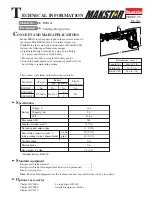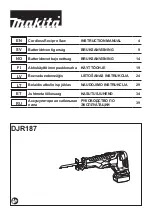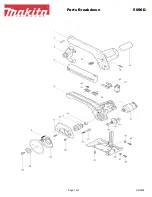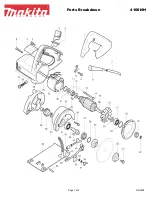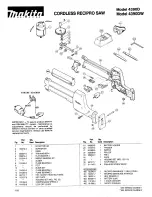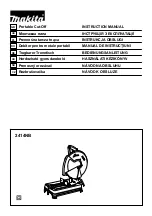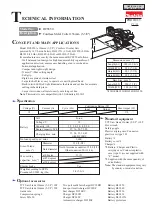
4
en
●
The tool should be repaired only by a trained electri-
cal specialist (Hilti service centre) using original Hilti
spare parts. Failure to observe this point my result in
a risk of accident to the user.
●
Never operate the tool when it is dirty or wet. Dust or
dampness on the surface of the tool make it difficult
to hold and, under unfavorable conditions, may lead
to electric shocks. Accordingly, have the tool checked
regularly at a Hilti service center if it is used frequently
for cutting conductive materials.
●
Avoid short circuiting the battery terminals. A short
circuit may cause a fire.
●
Ensure that the outer surface of the battery is clean
and dry before inserting the battery in the appropri-
ate charger for charging.
●
Check that the battery is securely attached to the tool.
A falling battery could injure you or other persons.
●
Batteries that have reached the end of their life must
be disposed of safely.
●
Hold tool by insulated gripping surfaces when per-
forming an operation where the cutting tool may con-
tact hidden wiring or its own cord.
Contact with a
“live” wire will make exposed metal parts of the tool
“live” and shock the operator.
●
Do not charge or continue to use damaged batter-
ies (e.g. batteries with cracks, broken parts, bent
or pushed-in and/or pulled-out contacts).
3.3.3 Thermal
●
The insert tool may become hot during use. You should
therefore wear protective gloves when changing insert
tools.
●
The cuttings produced when sawing, especially
metal cuttings, may be hot. Wear suitable protective
clothing.
3.3.4 Liquids
●
A caustic liquid may leak from defective batteries. Avoid
contact with this liquid. In the event of contact with the
skin, wash the area affected with soap and plenty of
water. Should the liquid come into contact with the
eyes, flush the eyes with water immediately and sub-
sequently consult a doctor.
3.3.5 Dust
●
Wear respiratory protection when the work causes dust.
●
Reduce the concentration of dust in the air by ensur-
ing good ventilation of the workplace.
●
Before beginning work, find out the hazard class of
the dust produced by the work and take appropriate
measures for personal protection.
●
Proposition 65 warning: This product contains or pro-
duces an exposure to chemicals known to the State
of California to cause cancer and birth defects (or other
reproductive harm).
●
WARNING: Some dust created by grinding, sanding,
cutting and drilling contains chemicals known to
cause cancer, birth defects, infertility or other repro-
ductive harm; or serious and permanent respirato-
ry or other injury.
Some examples of these chemicals
are: lead from leadbased paints, crystalline silica from
bricks, concrete and other masonry products and nat-
ural stone, arsenic and chromium from chemical-
lytreated lumber. Your risk from these exposures varies,
depending on how often you do this type of work.
To
reduce exposure to these chemicals, the operator
and bystanders should work in a well-ventilated area,
work with approved safety equipment, such as res-
piratory protection appropriate for the type of dust
generated, and designed to filter out microscopic
particles and direct dust away from the face and body.
Avoid prolonged contact with dust. Wear protective
clothing and wash exposed areas with soap and
water.
Allowing dust to get into your mouth, eyes, or
to remain on your skin may promote absorption of
harmful chemicals.
3.4 Requirements to be met by users
●
The tool is intended for professional use.
●
The tool may be operated, serviced and repaired only
by authorized, trained personnel. This personnel must
be informed of any special hazards that may be encoun-
tered.
●
Stay alert. Work carefully and sensibly. Do not use the
tool if your full concentration is not on the job.
●
Take breaks between working and do finger exercises
to relax the muscles and improve the blood circula-
tion in your fingers.
3.5 Personal protective equipment
The user and any other persons in the vicinity must wear
suitable eye protection. Ear protection, protective gloves
and respiratory protection should be worn as conditions
warrant.
3.6 Protective devices
Never use the tool without the hand guard fitted.
3.7 Symbols used on the tool
V
= volts
–––
- - -
= direct current
n
o
= no load stroke rate under no load
Wear ear
protection
Wear
protective
gloves
Wear
breathing
protection
Wear eye
protection
Printed: 07.07.2013 | Doc-Nr: PUB / 5071405 / 000 / 00
























